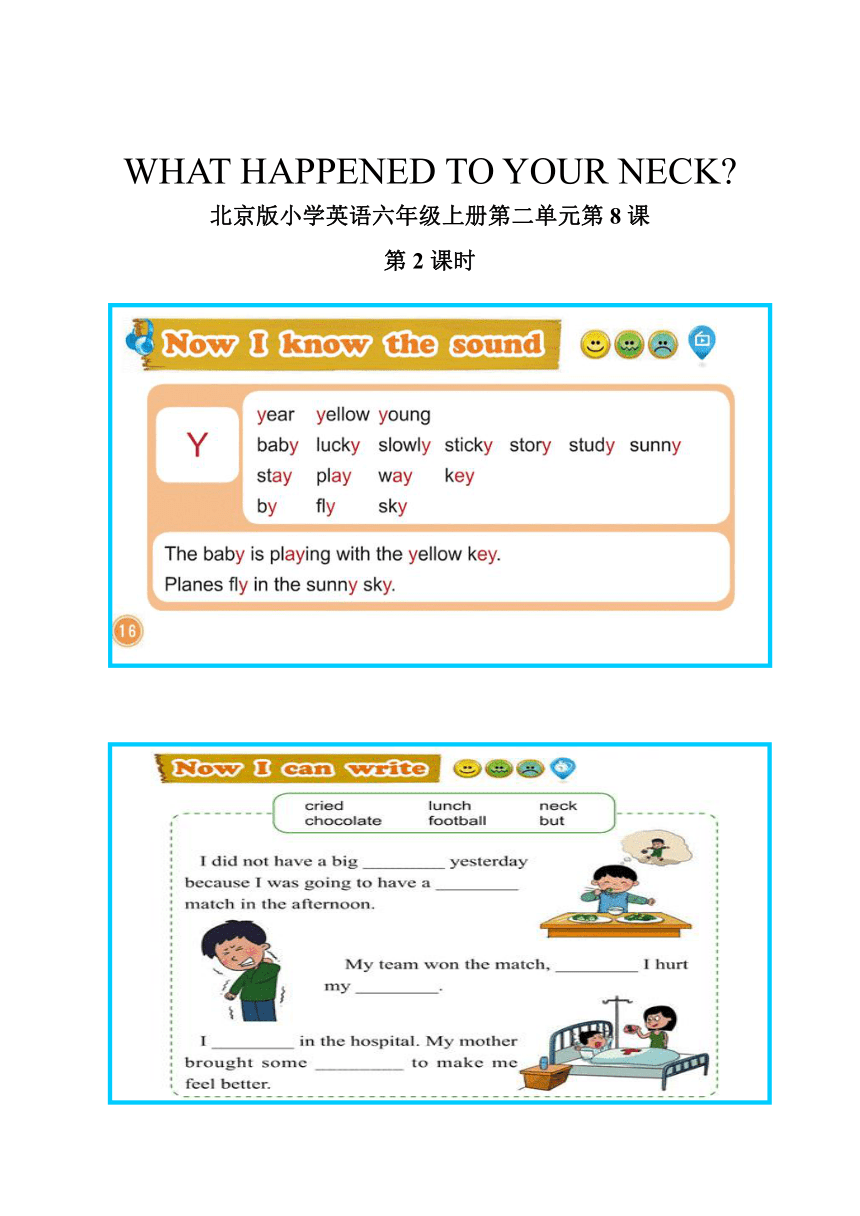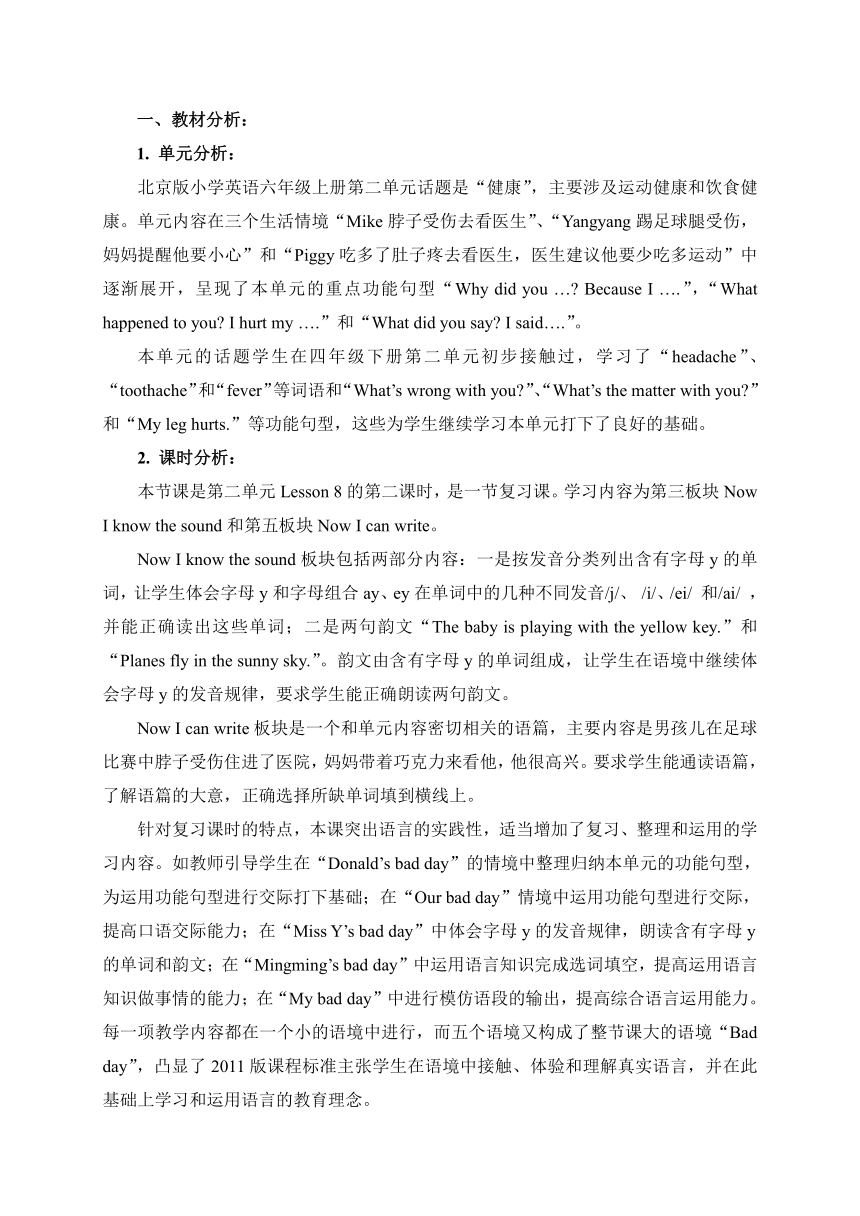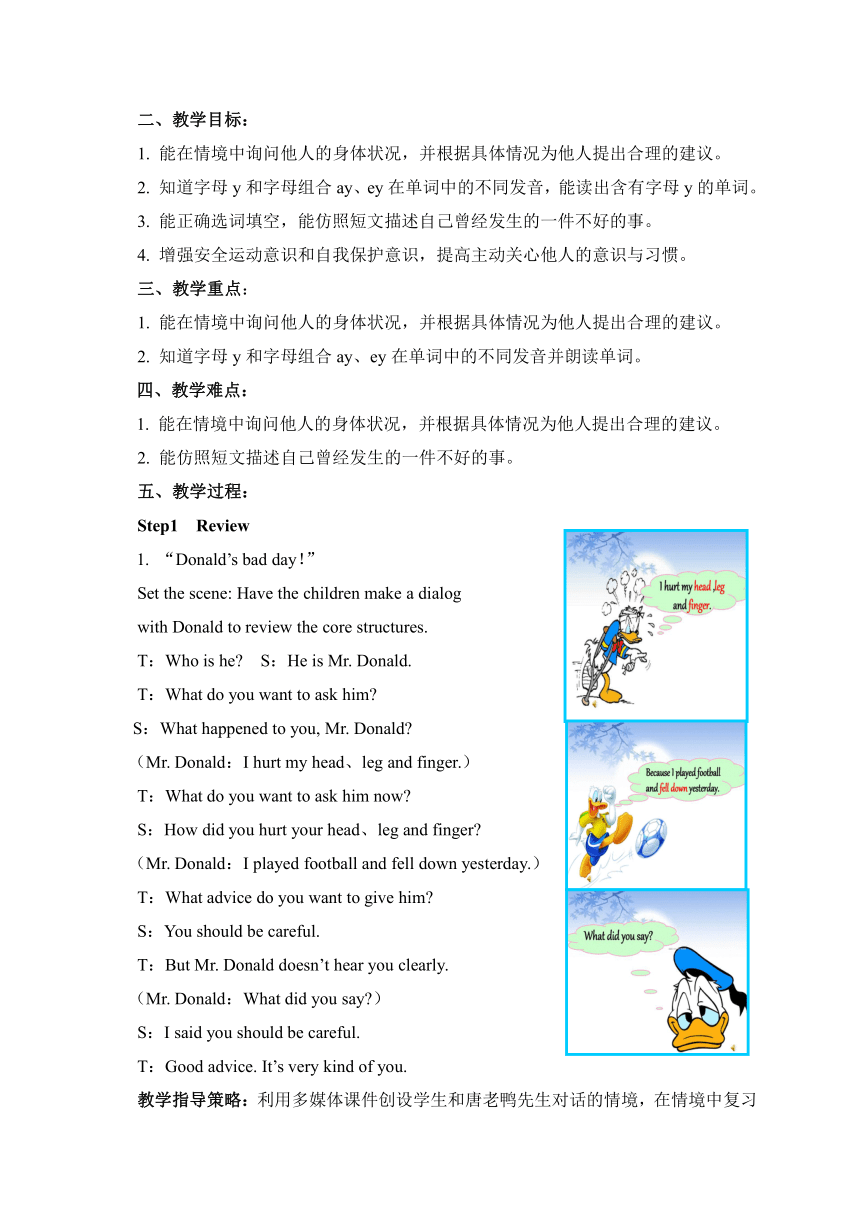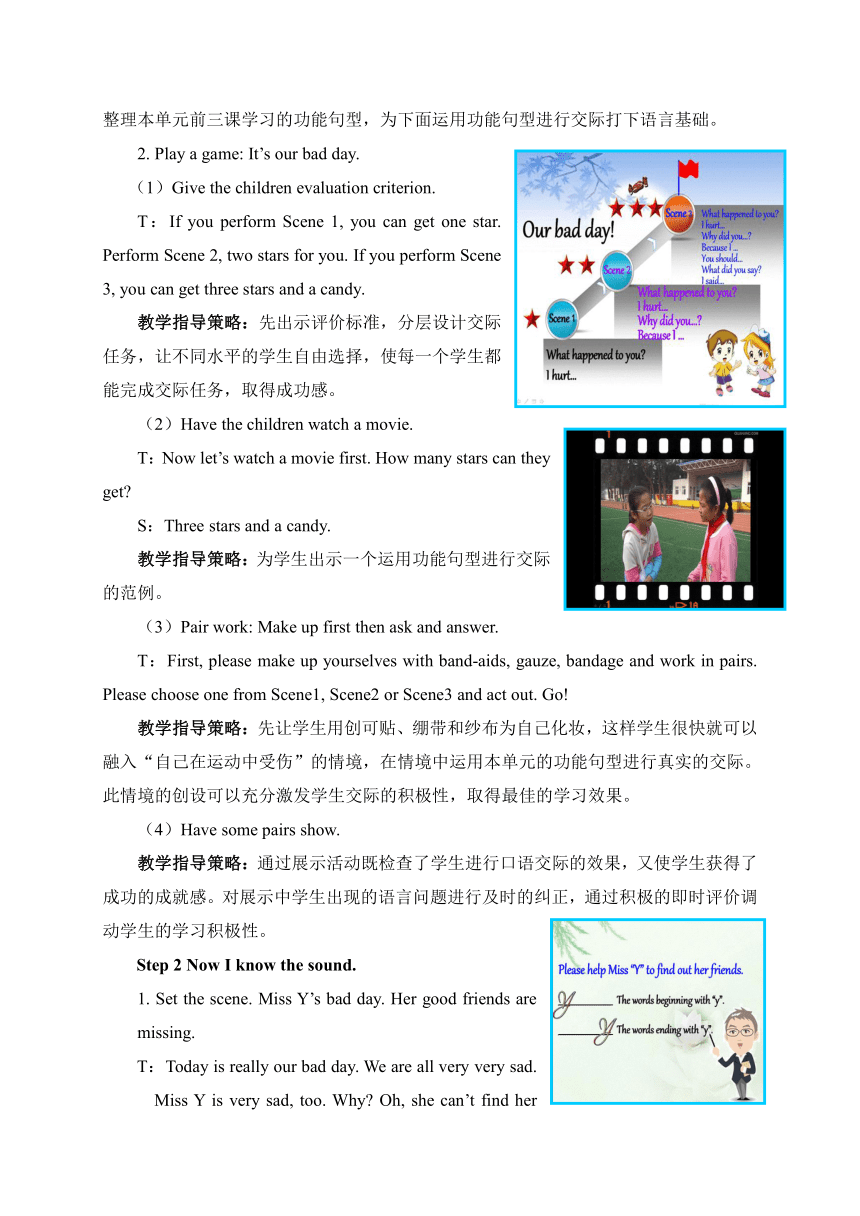Unit2 What happened to your neck? Lesson8 教案
文档属性
| 名称 | Unit2 What happened to your neck? Lesson8 教案 |  | |
| 格式 | doc | ||
| 文件大小 | 1.4MB | ||
| 资源类型 | 教案 | ||
| 版本资源 | 北京版 | ||
| 科目 | 英语 | ||
| 更新时间 | 2022-11-23 10:42:04 | ||
图片预览




文档简介
WHAT HAPPENED TO YOUR NECK
北京版小学英语六年级上册第二单元第8课
第2课时
一、教材分析:
1. 单元分析:
北京版小学英语六年级上册第二单元话题是“健康”,主要涉及运动健康和饮食健康。单元内容在三个生活情境“Mike脖子受伤去看医生”、“Yangyang踢足球腿受伤,妈妈提醒他要小心”和“Piggy吃多了肚子疼去看医生,医生建议他要少吃多运动”中逐渐展开,呈现了本单元的重点功能句型“Why did you … Because I ….”,“What happened to you I hurt my ….”和“What did you say I said….”。
本单元的话题学生在四年级下册第二单元初步接触过,学习了“headache”、“toothache”和“fever”等词语和“What’s wrong with you ”、“What’s the matter with you ”和“My leg hurts.”等功能句型,这些为学生继续学习本单元打下了良好的基础。
2. 课时分析:
本节课是第二单元Lesson 8的第二课时,是一节复习课。学习内容为第三板块Now I know the sound和第五板块Now I can write。
Now I know the sound板块包括两部分内容:一是按发音分类列出含有字母y的单词,让学生体会字母y和字母组合ay、ey在单词中的几种不同发音/j/、 /i/、/ei/ 和/ai/ ,并能正确读出这些单词;二是两句韵文“The baby is playing with the yellow key.”和“Planes fly in the sunny sky.”。韵文由含有字母y的单词组成,让学生在语境中继续体会字母y的发音规律,要求学生能正确朗读两句韵文。
Now I can write板块是一个和单元内容密切相关的语篇,主要内容是男孩儿在足球比赛中脖子受伤住进了医院,妈妈带着巧克力来看他,他很高兴。要求学生能通读语篇,了解语篇的大意,正确选择所缺单词填到横线上。
针对复习课时的特点,本课突出语言的实践性,适当增加了复习、整理和运用的学习内容。如教师引导学生在“Donald’s bad day”的情境中整理归纳本单元的功能句型,为运用功能句型进行交际打下基础;在“Our bad day”情境中运用功能句型进行交际,提高口语交际能力;在“Miss Y’s bad day”中体会字母y的发音规律,朗读含有字母y的单词和韵文;在“Mingming’s bad day”中运用语言知识完成选词填空,提高运用语言知识做事情的能力;在“My bad day”中进行模仿语段的输出,提高综合语言运用能力。每一项教学内容都在一个小的语境中进行,而五个语境又构成了整节课大的语境“Bad day”,凸显了2011版课程标准主张学生在语境中接触、体验和理解真实语言,并在此基础上学习和运用语言的教育理念。
二、教学目标:
1. 能在情境中询问他人的身体状况,并根据具体情况为他人提出合理的建议。
2. 知道字母y和字母组合ay、ey在单词中的不同发音,能读出含有字母y的单词。
3. 能正确选词填空,能仿照短文描述自己曾经发生的一件不好的事。
4. 增强安全运动意识和自我保护意识,提高主动关心他人的意识与习惯。
三、教学重点:
1. 能在情境中询问他人的身体状况,并根据具体情况为他人提出合理的建议。
2. 知道字母y和字母组合ay、ey在单词中的不同发音并朗读单词。
四、教学难点:
1. 能在情境中询问他人的身体状况,并根据具体情况为他人提出合理的建议。
2. 能仿照短文描述自己曾经发生的一件不好的事。
五、教学过程:
Step1 Review
1. “Donald’s bad day!”
Set the scene: Have the children make a dialog
with Donald to review the core structures.
T:Who is he S:He is Mr. Donald.
T:What do you want to ask him
S:What happened to you, Mr. Donald
(Mr. Donald:I hurt my head、leg and finger.)
T:What do you want to ask him now
S:How did you hurt your head、leg and finger
(Mr. Donald:I played football and fell down yesterday.)
T:What advice do you want to give him
S:You should be careful.
T:But Mr. Donald doesn’t hear you clearly.
(Mr. Donald:What did you say )
S:I said you should be careful.
T:Good advice. It’s very kind of you.
教学指导策略:利用多媒体课件创设学生和唐老鸭先生对话的情境,在情境中复习整理本单元前三课学习的功能句型,为下面运用功能句型进行交际打下语言基础。
2. Play a game: It’s our bad day.
(1)Give the children evaluation criterion.
T:If you perform Scene 1, you can get one star. Perform Scene 2, two stars for you. If you perform Scene 3, you can get three stars and a candy.
教学指导策略:先出示评价标准,分层设计交际任务,让不同水平的学生自由选择,使每一个学生都能完成交际任务,取得成功感。
(2)Have the children watch a movie.
T:Now let’s watch a movie first. How many stars can they get
S:Three stars and a candy.
教学指导策略:为学生出示一个运用功能句型进行交际的范例。
(3)Pair work: Make up first then ask and answer.
T:First, please make up yourselves with band-aids, gauze, bandage and work in pairs. Please choose one from Scene1, Scene2 or Scene3 and act out. Go!
教学指导策略:先让学生用创可贴、绷带和纱布为自己化妆,这样学生很快就可以融入“自己在运动中受伤”的情境,在情境中运用本单元的功能句型进行真实的交际。此情境的创设可以充分激发学生交际的积极性,取得最佳的学习效果。
(4)Have some pairs show.
教学指导策略:通过展示活动既检查了学生进行口语交际的效果,又使学生获得了成功的成就感。对展示中学生出现的语言问题进行及时的纠正,通过积极的即时评价调动学生的学习积极性。
Step 2 Now I know the sound.
1. Set the scene. Miss Y’s bad day. Her good friends are missing.
T:Today is really our bad day. We are all very very sad. Miss Y is very sad, too. Why Oh, she can’t find her friends. Let’s help her, OK
2. Group work: Have the children write some words that the first letter is“y”and the last letter is “y”. Write on the card.
教学指导策略:激活学生的已有知识,为体会字母y的发音规律做好准备。
3. Have the children stick the word cards on the blackboard. Have the children read the words together.
教学指导策略:让学生朗读单词,初步体会字母y在单词中的不同发音。
4. Have the children put the words in groups according to the pronunciation.
教学指导策略:让学生在小组内把自己所写的含有字母y的单词按不同的发音分类。通过分类活动使学生体会字母y在单词中的不同发音。
5. Teacher shows the rest words and have the children put them in the correct groups.
教学指导策略:教师补充出示学生没有想到的单词,让学生把它们按发音放到相应的位置,进一步帮助学生掌握字母y的发音规律。
6. To show the words on Page 16. Have the children try to read.
T:Now look at the screen. Please listen and repeat.
教学指导策略:出示书上按发音分类的单词,让学生大声朗读,一是检查自己刚才的归类是否正确,二是进一步体会字母y的发音规律。
7. Have the children read the sentences.
T:I have two tongue twisters. Please listen and repeat.
教学指导策略:本环节重点在于让学生继续体会字母y的发音规律,所以用合成图来直接呈现韵文的意思,重点放在学生的朗读上面。提示学生要注意单词在句子中语音语调的变化。
Step 3 Now I can write.
1. Set the scene.
T:Today is Miss Y’s bad day. But yesterday was Mingming’s bad day.
教学指导策略:创设情境,由语音板块过渡到选词填空板块。
Teacher shows the picture. Ask some questions. Elicit the answers from the children.
T:What happened to Mingming
S:He hurt his neck.
T:How did he hurt his neck
S:He had a football match.
T:What did he do before the football match
S:He had lunch.
T:Where was Mingming
S:He was in the hospital.
T:What did his mother bring him
S:She brought some chocolate to him.
教学指导策略:学生在情境中回答老师的问题,也是学生初步了解语篇大意的过程。
2. Teacher shows the words to help the children understand them with the pictures.
教学指导策略:语篇中的所缺词语都是学生已经学过的单词,用图片的方式帮学生回忆单词的意思,为选词填空做好准备。
3. Have the children complete the passage with the words.
教学指导策略:学生独立完成选词填空,培养学生运用能力。
4. Have the children check the answer with each other.
T:This is a big lunch. This is not a big lunch.
教学指导策略:让学生互相检查选词填空完成情况,培养合作意识与习惯。在检查的过程中用图片帮助学生理解“big lunch”。
Step 4 Extension
1. Have the children read the passage.
T:Now let’s read the story aloud. Please pay attention to the pronunciation and intonation
教学指导策略:让学生整体回顾语篇的内容,培养学生有语气地朗读语篇的能力。在学生朗读的过程中教师指导学生按意群进行朗读,对学生朗读时出现的语音语调的问题进行及时的指导。
2. Our own Story .
T:This is Mingming’s bad day. But do you have a bad day I think you must have a bad day. For example, hurt foot, had a headache. What’s your bad day
S:Answer the teacher’s question.
(1)Give the children a model. “My bad day”
T:Oh, so many bad days. First, look at my bad day. Look at my scar first. I went to work by bike one day ten years ago. I rode into a puddle(水洼儿). I fell off the bike. I hurt my wrist. My friends took me to the hospital. My wrist ached terribly but I didn’t cry. That was my bad day.
教学指导策略:教师先让学生看自己手腕上的伤疤,以自己真实的经历为学生做一个示范,鼓励学生用所学语言知识讲出自己真实的故事,培养学生用英语做事情的意识与习惯。
(2)Group Work: Talk about “My bad day”.
(3)Have some children show.
教学指导策略:通过展示活动,使学生获得成功的喜悦。另外,对于学生在描述中出现的语言错误,特别是过去时态的使用,进行及时的指导与纠正。
Step 5 Summary
Teacher shows the warm notice :“Take care of yourself, the safety is first.”
T:Today. We know Donald’s bad day. Miss. Y’s bad day. Mingming’s bad day and our bad day. So we should remember this warm notice: Take care of your self. The safety is first. Today we all have a good job in the class. So we are all the lucky children. Let’s clap for ourselves.
教学指导策略:通过温馨提示培养学生的安全运动意识和自我保护意识。用积极的评价激发学生的积极性。
六、板书设计
北京版小学英语六年级上册第二单元第8课
第2课时
一、教材分析:
1. 单元分析:
北京版小学英语六年级上册第二单元话题是“健康”,主要涉及运动健康和饮食健康。单元内容在三个生活情境“Mike脖子受伤去看医生”、“Yangyang踢足球腿受伤,妈妈提醒他要小心”和“Piggy吃多了肚子疼去看医生,医生建议他要少吃多运动”中逐渐展开,呈现了本单元的重点功能句型“Why did you … Because I ….”,“What happened to you I hurt my ….”和“What did you say I said….”。
本单元的话题学生在四年级下册第二单元初步接触过,学习了“headache”、“toothache”和“fever”等词语和“What’s wrong with you ”、“What’s the matter with you ”和“My leg hurts.”等功能句型,这些为学生继续学习本单元打下了良好的基础。
2. 课时分析:
本节课是第二单元Lesson 8的第二课时,是一节复习课。学习内容为第三板块Now I know the sound和第五板块Now I can write。
Now I know the sound板块包括两部分内容:一是按发音分类列出含有字母y的单词,让学生体会字母y和字母组合ay、ey在单词中的几种不同发音/j/、 /i/、/ei/ 和/ai/ ,并能正确读出这些单词;二是两句韵文“The baby is playing with the yellow key.”和“Planes fly in the sunny sky.”。韵文由含有字母y的单词组成,让学生在语境中继续体会字母y的发音规律,要求学生能正确朗读两句韵文。
Now I can write板块是一个和单元内容密切相关的语篇,主要内容是男孩儿在足球比赛中脖子受伤住进了医院,妈妈带着巧克力来看他,他很高兴。要求学生能通读语篇,了解语篇的大意,正确选择所缺单词填到横线上。
针对复习课时的特点,本课突出语言的实践性,适当增加了复习、整理和运用的学习内容。如教师引导学生在“Donald’s bad day”的情境中整理归纳本单元的功能句型,为运用功能句型进行交际打下基础;在“Our bad day”情境中运用功能句型进行交际,提高口语交际能力;在“Miss Y’s bad day”中体会字母y的发音规律,朗读含有字母y的单词和韵文;在“Mingming’s bad day”中运用语言知识完成选词填空,提高运用语言知识做事情的能力;在“My bad day”中进行模仿语段的输出,提高综合语言运用能力。每一项教学内容都在一个小的语境中进行,而五个语境又构成了整节课大的语境“Bad day”,凸显了2011版课程标准主张学生在语境中接触、体验和理解真实语言,并在此基础上学习和运用语言的教育理念。
二、教学目标:
1. 能在情境中询问他人的身体状况,并根据具体情况为他人提出合理的建议。
2. 知道字母y和字母组合ay、ey在单词中的不同发音,能读出含有字母y的单词。
3. 能正确选词填空,能仿照短文描述自己曾经发生的一件不好的事。
4. 增强安全运动意识和自我保护意识,提高主动关心他人的意识与习惯。
三、教学重点:
1. 能在情境中询问他人的身体状况,并根据具体情况为他人提出合理的建议。
2. 知道字母y和字母组合ay、ey在单词中的不同发音并朗读单词。
四、教学难点:
1. 能在情境中询问他人的身体状况,并根据具体情况为他人提出合理的建议。
2. 能仿照短文描述自己曾经发生的一件不好的事。
五、教学过程:
Step1 Review
1. “Donald’s bad day!”
Set the scene: Have the children make a dialog
with Donald to review the core structures.
T:Who is he S:He is Mr. Donald.
T:What do you want to ask him
S:What happened to you, Mr. Donald
(Mr. Donald:I hurt my head、leg and finger.)
T:What do you want to ask him now
S:How did you hurt your head、leg and finger
(Mr. Donald:I played football and fell down yesterday.)
T:What advice do you want to give him
S:You should be careful.
T:But Mr. Donald doesn’t hear you clearly.
(Mr. Donald:What did you say )
S:I said you should be careful.
T:Good advice. It’s very kind of you.
教学指导策略:利用多媒体课件创设学生和唐老鸭先生对话的情境,在情境中复习整理本单元前三课学习的功能句型,为下面运用功能句型进行交际打下语言基础。
2. Play a game: It’s our bad day.
(1)Give the children evaluation criterion.
T:If you perform Scene 1, you can get one star. Perform Scene 2, two stars for you. If you perform Scene 3, you can get three stars and a candy.
教学指导策略:先出示评价标准,分层设计交际任务,让不同水平的学生自由选择,使每一个学生都能完成交际任务,取得成功感。
(2)Have the children watch a movie.
T:Now let’s watch a movie first. How many stars can they get
S:Three stars and a candy.
教学指导策略:为学生出示一个运用功能句型进行交际的范例。
(3)Pair work: Make up first then ask and answer.
T:First, please make up yourselves with band-aids, gauze, bandage and work in pairs. Please choose one from Scene1, Scene2 or Scene3 and act out. Go!
教学指导策略:先让学生用创可贴、绷带和纱布为自己化妆,这样学生很快就可以融入“自己在运动中受伤”的情境,在情境中运用本单元的功能句型进行真实的交际。此情境的创设可以充分激发学生交际的积极性,取得最佳的学习效果。
(4)Have some pairs show.
教学指导策略:通过展示活动既检查了学生进行口语交际的效果,又使学生获得了成功的成就感。对展示中学生出现的语言问题进行及时的纠正,通过积极的即时评价调动学生的学习积极性。
Step 2 Now I know the sound.
1. Set the scene. Miss Y’s bad day. Her good friends are missing.
T:Today is really our bad day. We are all very very sad. Miss Y is very sad, too. Why Oh, she can’t find her friends. Let’s help her, OK
2. Group work: Have the children write some words that the first letter is“y”and the last letter is “y”. Write on the card.
教学指导策略:激活学生的已有知识,为体会字母y的发音规律做好准备。
3. Have the children stick the word cards on the blackboard. Have the children read the words together.
教学指导策略:让学生朗读单词,初步体会字母y在单词中的不同发音。
4. Have the children put the words in groups according to the pronunciation.
教学指导策略:让学生在小组内把自己所写的含有字母y的单词按不同的发音分类。通过分类活动使学生体会字母y在单词中的不同发音。
5. Teacher shows the rest words and have the children put them in the correct groups.
教学指导策略:教师补充出示学生没有想到的单词,让学生把它们按发音放到相应的位置,进一步帮助学生掌握字母y的发音规律。
6. To show the words on Page 16. Have the children try to read.
T:Now look at the screen. Please listen and repeat.
教学指导策略:出示书上按发音分类的单词,让学生大声朗读,一是检查自己刚才的归类是否正确,二是进一步体会字母y的发音规律。
7. Have the children read the sentences.
T:I have two tongue twisters. Please listen and repeat.
教学指导策略:本环节重点在于让学生继续体会字母y的发音规律,所以用合成图来直接呈现韵文的意思,重点放在学生的朗读上面。提示学生要注意单词在句子中语音语调的变化。
Step 3 Now I can write.
1. Set the scene.
T:Today is Miss Y’s bad day. But yesterday was Mingming’s bad day.
教学指导策略:创设情境,由语音板块过渡到选词填空板块。
Teacher shows the picture. Ask some questions. Elicit the answers from the children.
T:What happened to Mingming
S:He hurt his neck.
T:How did he hurt his neck
S:He had a football match.
T:What did he do before the football match
S:He had lunch.
T:Where was Mingming
S:He was in the hospital.
T:What did his mother bring him
S:She brought some chocolate to him.
教学指导策略:学生在情境中回答老师的问题,也是学生初步了解语篇大意的过程。
2. Teacher shows the words to help the children understand them with the pictures.
教学指导策略:语篇中的所缺词语都是学生已经学过的单词,用图片的方式帮学生回忆单词的意思,为选词填空做好准备。
3. Have the children complete the passage with the words.
教学指导策略:学生独立完成选词填空,培养学生运用能力。
4. Have the children check the answer with each other.
T:This is a big lunch. This is not a big lunch.
教学指导策略:让学生互相检查选词填空完成情况,培养合作意识与习惯。在检查的过程中用图片帮助学生理解“big lunch”。
Step 4 Extension
1. Have the children read the passage.
T:Now let’s read the story aloud. Please pay attention to the pronunciation and intonation
教学指导策略:让学生整体回顾语篇的内容,培养学生有语气地朗读语篇的能力。在学生朗读的过程中教师指导学生按意群进行朗读,对学生朗读时出现的语音语调的问题进行及时的指导。
2. Our own Story .
T:This is Mingming’s bad day. But do you have a bad day I think you must have a bad day. For example, hurt foot, had a headache. What’s your bad day
S:Answer the teacher’s question.
(1)Give the children a model. “My bad day”
T:Oh, so many bad days. First, look at my bad day. Look at my scar first. I went to work by bike one day ten years ago. I rode into a puddle(水洼儿). I fell off the bike. I hurt my wrist. My friends took me to the hospital. My wrist ached terribly but I didn’t cry. That was my bad day.
教学指导策略:教师先让学生看自己手腕上的伤疤,以自己真实的经历为学生做一个示范,鼓励学生用所学语言知识讲出自己真实的故事,培养学生用英语做事情的意识与习惯。
(2)Group Work: Talk about “My bad day”.
(3)Have some children show.
教学指导策略:通过展示活动,使学生获得成功的喜悦。另外,对于学生在描述中出现的语言错误,特别是过去时态的使用,进行及时的指导与纠正。
Step 5 Summary
Teacher shows the warm notice :“Take care of yourself, the safety is first.”
T:Today. We know Donald’s bad day. Miss. Y’s bad day. Mingming’s bad day and our bad day. So we should remember this warm notice: Take care of your self. The safety is first. Today we all have a good job in the class. So we are all the lucky children. Let’s clap for ourselves.
教学指导策略:通过温馨提示培养学生的安全运动意识和自我保护意识。用积极的评价激发学生的积极性。
六、板书设计
同课章节目录
- Unit 1 What did you do this summer?
- Lesson 1
- Lesson 2
- Lesson 3
- Lesson 4
- Unit 2 What happened to your neck?
- Lesson 5
- Lesson 6
- Lesson 7
- Lesson 8
- Unit 3 How did you go to Hangzhou?
- Lesson 9
- Lesson 10
- Lesson 11
- Lesson 12
- Unit 4 Revision
- Lesson 13
- Lesson 14
- Unit 5 When did the ancient Olympic Games begin?
- Lesson 15
- Lesson 16
- Lesson 17
- Lesson 18
- Unit 6 What is he wearing?
- Lesson 19
- Lesson 20
- Lesson 21
- Lesson 22
- Unit 7 What are the twelve animals?
- Lesson 23
- Lesson 24
- Lesson 25
- Lesson 26
- Unit 8 Revision
- Lesson 27
- Lesson 28
